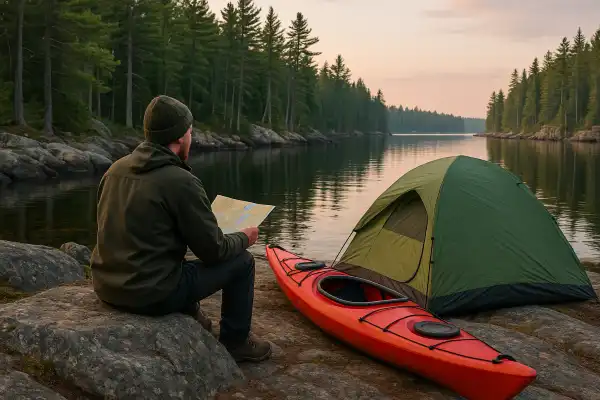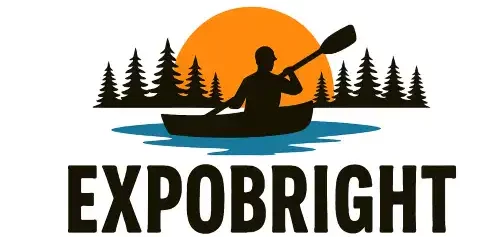Where can you kayak camp in Maine draws thousands of paddlers northward each summer, seeking pristine waters and remote campsites that promise solitude beneath star-filled skies. Maine’s vast network of lakes, rivers, and coastal islands creates an unmatched tapestry of paddling destinations where wilderness camping becomes an art form.
Last September, I found myself explaining to a fellow paddler why Maine consistently ranks among North America’s premier kayak camping destinations. From my decades exploring these waters—starting with childhood expeditions through remote Downeast lakes to recent coastal island adventures—I’ve witnessed firsthand how Maine’s geography creates perfect conditions for multi-day paddle-camping trips that range from beginner-friendly lake circuits to challenging offshore island expeditions.
Must read for your safety when kayak camping: How to get rid of spider in a kayak?
Where can you kayak camp in Maine?
Maine offers kayak camping across nearly 200 coastal islands through the Maine Island Trail, plus dozens of remote lake and river systems with primitive camping sites throughout the state’s interior. The state’s backcountry campsites are predominantly accessed by boat, often canoe or kayak, providing paddlers with extensive wilderness camping opportunities.

Coastal Island Camping
The Maine Island Trail extends from the New Hampshire border to Canada, featuring over 200 islands to visit and camp on. This represents America’s first water trail and offers some of the world’s finest sea kayak camping experiences.
Cape Porpoise Islands near Kennebunkport provide accessible coastal camping for paddlers of all skill levels. Vaughn Island sits nearest the shore with a spacious oak tree-shaded campsite, while Trott Island offers an easy-to-land site on the south end with space for three tents in the pine woods. The proximity to shore makes these islands ideal for first-time ocean kayak campers.
Acadia Region Islands offer dramatic camping experiences within sight of Maine’s most famous national park. Duck Harbor on Isle au Haut features 5 remote campsites with wooden 3-sided shelters, water spigot, picnic tables, and composting outhouse, plus access to over 20 miles of hiking trails. The oceanfront campsites face the open Atlantic, providing unforgettable sunrise views.
Muscongus Bay Islands create perfect island-hopping opportunities for multi-day trips. The area supports overnight camping trips where paddlers can enjoy island-to-island touring with full gourmet meals prepared ocean-side while watching gorgeous sunsets.
Interior Lake Systems
Moosehead Lake stands as Maine’s largest lake and offers exceptional kayak camping opportunities across its 75,000-acre expanse. Many primitive campsites line the shores, with some located on bigger islands like Sugar Island, all available on a first-come, first-served basis with no fees except at Lily Bay State Park. Sugar Island provides remote camping experiences with sites like Porcupine Point offering dramatic lake views.
Rangeley Lakes Region encompasses a chain of interconnected lakes perfect for extended paddle-camping circuits. Wilderness campsites run by the Stephen Phillips Memorial Trust are scattered along the western shore and small islands of Mooselookmeguntic Lake. Paddlers can create an 8-mile trip across Rangeley Lake to Oquossoc with a portage to Haines Landing on Mooselookmeguntic Lake.
Downeast Lakes near Grand Lake Stream offer some of Maine’s most remote paddling and camping experiences. Eleven water-access campsites allow various multi-day trip options, with camping free and available on a first-come basis with a maximum stay of 3 nights per site. The region connects traditional canoe travel between the Saint Croix, Machias, and Penobscot River watersheds.
Wilderness Waterways
Allagash Wilderness Waterway represents Maine’s most famous canoe camping destination. Established in 1966 and designated as the first state-administered component of the National Wild and Scenic River System, the 92-mile waterway offers one of America’s preeminent canoe trips. The Allagash provides 92 miles of the most pristine and remote backcountry camping in the state.
Penobscot River Corridor provides 67 miles of river and 70 miles of lake frontage for extended wilderness camping expeditions. Located in the heart of Maine’s undeveloped forest land, the corridor offers extensive backcountry camping opportunities.
St. Croix River creates excellent opportunities for first-time and experienced wilderness campers alike. Known for lively but mostly easy whitewater, rustic but maintained campsites, and fishing for smallmouth bass, the river accommodates paddlers of all skill levels.
Remote Mountain Lakes
Deboullie Public Lands in north-central Aroostook County offer remote campsites on crystal-clear trout ponds surrounded by low rugged mountains, with several water-accessed campsites available.
Nahmakanta Public Lands feature six pristine water-accessible campsites on Nahmakanta Lake as well as several hike-to campsites available to paddlers and hikers.
Chain of Ponds Public Lands near the Quebec border include Natanis, Long, Bag, and Lower Ponds joined by short thoroughfares, offering lake shore camping at primitive remote sites.
State Park Water Access
Several Maine State Parks provide excellent launching points and camping facilities for kayak camping adventures:
Lily Bay State Park on Moosehead Lake offers waterfront camping at the gateway to Maine’s North Woods with two boat launch sites enabling exploration of the park’s shore and nearby Sugar Island.
Rangeley Lake State Park provides fifty campsites and two group campsites with boat launch access, perfect for exploring the Rangeley Lakes chain.
Lamoine State Park near Acadia offers quiet camping that provides easy access to Bar Harbor, Acadia National Park, rockbound islands, and area lighthouses with a paved boat ramp accessing Eastern Bay.
Conclusion
Three weeks ago, I guided a family through their first Maine kayak camping experience at the Cape Porpoise Islands. We launched from Kennebunkport harbor under overcast skies, but by evening we were watching a spectacular sunset from our Vaughn Island campsite while the kids collected shells along the cobbled beach. The father later told me that having a detailed location guide beforehand made the difference between a stressful guessing game and a confident adventure—knowing exactly where to find suitable campsites, launch points, and backup options transformed their family vacation from uncertain to unforgettable. Proper planning opens the door to Maine’s most spectacular paddling destinations, turning first-time jitters into lifelong memories beneath Maine’s endless skies.
Follow Expobright for exclusive kayak and canoe camping tips.
